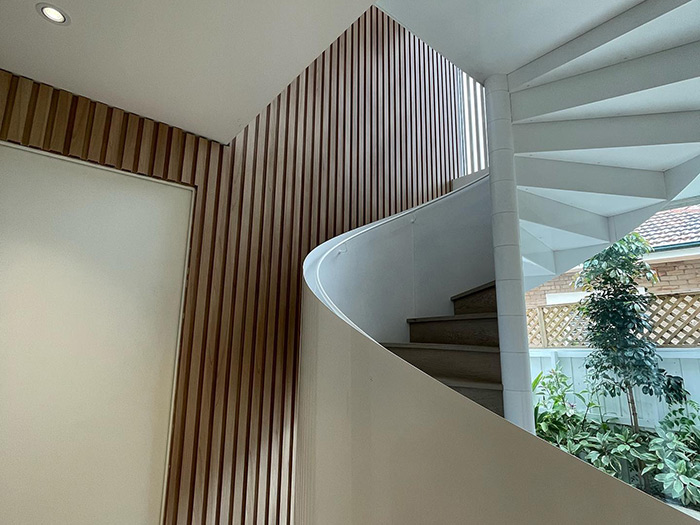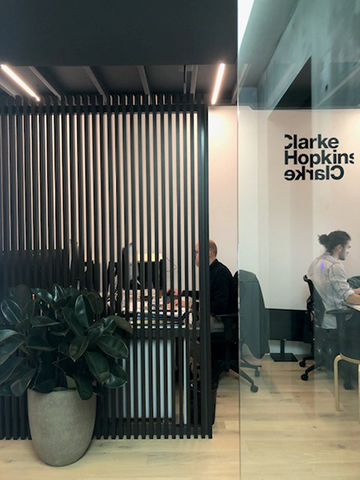As the concern for planetary health grows to become one of the most consequential drivers behind the shift in the architecture, design and construction industry, interiors emerge as powerful symbols of this transition. And for good reason: it turns out we spend an overwhelming majority of our lives indoors, and the choices we make in designing and constructing these spaces directly impact the health and well-being of their occupants.
“People in modern societies spend 90% of their time indoors breathing indoor air,” explains Professor Lidia Morawska, an ARC Australian Laureate Fellow who researches air quality and its impact on human health. “And although there are building codes in place for the construction of these spaces, there is generally nothing in place to address the ongoing operation of these buildings in respect of air quality and the levels of pollutants that people are exposed to.”
In addition, as Professor Richard de Dear from the Sydney School of Architecture, Design and Planning, who is the Director of the University’s Indoor Environmental Quality (IEQ) Lab points out, “research shows the considerable impact that IEQ factors can have on productivity in the workplace and building sustainability.”These findings are underscored by the risk studies performed by the US EPA and its Science Advisory Board which place indoor air pollution in the top five environmental risks to public health.
The message is clear: it's crucial to consider the indoor environment with the same rigour we apply when interrogating the environmental impact of the built environment on the planetary level and ensuring indoor air quality is absolutely fundamental. And to do so, architects, designers, and specifiers must turn their attention to Volatile Organic Compounds (VOCs).

Decoding VOCs
VOCs are invisible carbon-containing chemicals that can significantly compromise indoor air quality – especially as they are readily released from everyday materials. Beyond the commonly known sources like paints, adhesives, and furniture, VOCs can also emanate from other common products and materials, including flooring solutions, insulation, composite wood products, and caulks and sealants. This problem is compounded by the use of conventional cleaning products, many of which contain VOCs that can linger in the air and surfaces long after use.
The presence of these invisible pollutants in our indoor spaces can affect productivity, cognitive function, and overall quality of life, but it also poses a threat to human health. VOCs can cause eye, nose, and throat irritation, as well as headaches and dizziness. In addition, long-term exposure to these compounds can lead to more severe health issues, including asthma, certain types of cancer, and even damage to vital organs. In fact, we're all too familiar with "sick building syndrome," a condition in which occupants experience various health problems linked to time spent indoors – an unfortunate phenomenon that underscores the critical importance of addressing VOCs in indoor environments.
But the impact of VOCs extends beyond our interiors – they have tremendous implications for the broader ecosystem. They contribute to outdoor air pollution, exacerbating existing environmental challenges and compounding the climate crisis. Architects, designers, and specifiers have a responsibility to prioritise the health and well-being of building occupants as well as planetary health. By making informed material choices and advocating for low-VOC or VOC-free products, they can champion spaces that promote both environmental sustainability and human health.
Non-VOC products for healthier interiors
Formulated or manufactured to emit little to no Volatile Organic Compounds, non-VOC materials play a pivotal role in enhancing indoor air quality by minimising or entirely eliminating the release of harmful chemicals.
By replacing traditional, high-VOC materials with non-VOC alternatives, architects, designers, and specifiers can not only mitigate health risks like respiratory issues, allergies, and chronic illnesses, but help enhance occupant comfort, contributing to improved indoor air quality and reduced discomfort or irritation caused by harmful VOCs. Plus, many non-VOC products are formulated with sustainable materials, promoting a more environmentally responsible built environment.

An excellent example of a comprehensive VOC-free building product is DECO’s versatile range of aluminium building products, renowned for its signature powder coat finishes. Through a dry application method that involves electrostatic charging and heat curing, DECO’s innovative powder-coating process yields an exceptionally durable and visually striking finish without the release of harmful VOC pollutants.
DECO aluminium: A comprehensive choice for healthier interiors
A product that particularly stands out amongst DECO’s comprehensive range is DecoWood®, an innovative aluminium finish that beautifully recreates the look and feel of natural timber while offering the superior performance, durability and ease of use of aluminium. During the manufacturing process, the images of timber grain are sublimated into the coating, ensuring outstanding photographic precision and realistic visual results.
It's worth noting that the DecoWood timber grain finish has been tested and certified to comply with the international LEED (Leadership in Energy and Environmental Design) green building rating scheme as “low-emitting products” and its aesthetic appeal does not compromise the durability of the products. In fact, DecoWood is 50% more durable than other standard wood grain powder coatings available in Australia. DECO’s timber grain finishes are also rigorously tested, and comply with both Qualicoat, an international standard for quality assurance in powder coating, and Australian Standard 3715 which collectively set out 18 tests to ensure the integrity of the powder coating.
In addition, all DECO products are pre-finished, eliminating the need for any on-site painting or staining, a process often associated with the release of VOCs. By removing this step, DECO contributes to a healthier indoor environment from the moment of installation.
The outstanding profile of DECO aluminium products is further enhanced by numerous material benefits that extend beyond exceptional indoor air quality and endurance. Apart from exceptional resilience and no VOC emissions, their low-maintenance nature streamlines ongoing upkeep and reduces the need for cleaning products or refinishing, further minimising the potential for exposure to harmful substances.
Making any space a healthier one
The adaptability of DECO aluminium products translates into a wide array of interior applications – each a genuine statement on the brand’s commitment to beautiful versatility, environmental responsibility and occupant health.
First up, DECO aluminium panels, available in a variety of colours and finishes, including the biophilic aesthetic of DecoWood, can be used to create visually stunning ceilings and wall cladding that elevate the ambiance of a space while promoting optimal indoor air quality. Similarly, when specified as wall panels, DECO aluminium products offer a hygienic and durable solution for areas prone to moisture or heavy use, such as kitchens and bathrooms. And that’s not all. DECO’s versatile products can also bring a touch of dynamic sophistication when incorporated as stylish interior battens, enhancing any surface, feature walls, staircases, or even – thanks to their non-combustible nature – fireplace surrounds.

Through these versatile applications, DECO’s aluminium panels offer architects, designers and specifiers an opportunity to choose VOC-free composition and help create a healthier, more resilient, durable and aesthetically stunning built environment. Now, it’s clear that selecting VOC-free alternatives is non-negotiable. But there’s more than just looking for the “low-VOC” or “no-VOC” labels.
A guide to selecting non-VOC products
A comprehensive understanding of product composition and manufacturing processes is pivotal to an informed specification process, and that undoubtedly starts with thorough research. It’s also crucial to assess relevant manufacturers, suppliers, and distributors and seek those who clearly communicate their commitment to environmental responsibility, provide detailed information about their products' VOC emissions, and possess independent certifications to validate these claims.
Another essential consideration is the product’s entire lifecycle. Often, VOC emissions can occur not only during installation but also throughout a product's lifespan or at its end-of-life stage. That’s why it’s pivotal to select materials that are inherently low-VOC or VOC-free, require low maintenance and are recyclable or biodegradable (such as powder-coated aluminium), and avoid those that require harsh cleaning agents or off-gas over time.
Lastly, there are some useful resources that delve deeper into the topic of indoor air quality verification methods, like the “Indoor Air Quality” handbook produced by the Australian Building Codes Board (ABCB). The booklet aims to foster a greater understanding of the IAQ Verification Methods outlined in the National Construction Code (NCC) Volumes One and Two, specifically Verification Methods FV4.1 and FV4.2 of NCC Volume One and Verification Method V2.4.5 of NCC Volume Two.
What’s next?
Once the commitment to prioritising indoor quality has been made, it’s important to consider other factors that extend beyond VOC-free material selection. Early planning and specification of low-VOC or non-VOC materials from the outset of the project is paramount and will help ensure that the project team is aware of the commitment.
In addition, effective ventilation is critical to managing VOCs, and it’s important to consider strategies like operable windows and cross-ventilation, supplementing these with mechanical ventilation systems where necessary. At the same time, it's crucial to maintain adequate airflow during the construction stage to facilitate the dissipation of any present VOCs.
A collective responsibility
Architects, designers, and specifiers are in a unique position: they possess the power to influence the built environment in a way that safeguards human health and planetary well-being. By championing the use of non-VOC products – like DECO aluminium – they can actively contribute to a future where interiors are not only stunning and functional, but also resilient, comfortable and conducive to optimal health.

The shift towards prioritising indoor air quality and planetary health is an essential evolution in how we approach interior architecture. And while according to the Government's Department of Climate Change, Energy, the Environment and Water, Australia currently has no specific controls on indoor air quality – apart from workplace situations under the National Occupational Health and Safety Commission – by making informed choices and advocating for healthier materials, the industry can create spaces that nurture and protect, ensuring a brighter and more sustainable future for generations to come. By embracing innovative solutions like DecoWood, we can create spaces that enable humans to thrive.

